In Situ Construction of a Co2P/CoP Heterojunction Embedded on N-Doped Carbon as an Efficient Electrocatalyst for a Hydrogen Evolution Reaction
Abstract
:1. Introduction
2. Materials and Methods
2.1. Materials
2.2. Preparation of CoC2O4/Polyaniline–Phytic-Acid (CoC2O4/PANI-PA) Precursor
2.3. Preparation of Electrocatalysts
2.4. Structural Characterization
2.5. Electrochemical Characterization
3. Results and Discussion
4. Conclusions
Supplementary Materials
Author Contributions
Funding
Institutional Review Board Statement
Informed Consent Statement
Data Availability Statement
Conflicts of Interest
References
- Zhu, B.J.; Zou, R.Q.; Xu, Q. Metal-Organic Framework Based Catalysts for Hydrogen Evolution. Adv. Energy Mater. 2018, 8, 1801193. [Google Scholar] [CrossRef]
- Liu, Y.H.; Wang, Q.L.; Zhang, J.C.; Ding, J.; Cheng, Y.Q.; Wang, T.; Li, J.; Hu, F.X.; Yang, H.B.; Liu, B. Recent Advances in Carbon-Supported Noble-Metal Electrocatalysts for Hydrogen Evolution Reaction: Syntheses, Structures, and Properties. Adv. Energy Mater. 2022, 12, 2200928. [Google Scholar] [CrossRef]
- Han, J.X.; Gong, C.H.; He, C.; He, P.R.; Zhang, J.; Zhang, Z.G. Sub-1 nm Pt nanoclusters on N and P co-doped carbon nanotubes for the electrocatalytic hydrogen evolution reaction. J. Mater. Chem. A 2022, 10, 16403–16408. [Google Scholar] [CrossRef]
- Han, Y.; Duan, H.L.; Liu, W.; Zhou, C.H.; Wang, B.S.; Jiang, Q.Y.; Feng, S.H.; Yan, W.S.; Tan, T.; Zhang, R.F. Engineering the electronic structure of platinum single-atom sites via tailored porous carbon nanofibers for large-scale hydrogen production. Appl. Catal. B-Environ. 2023, 335, 122898. [Google Scholar] [CrossRef]
- Wang, F.; Hu, L.; Liu, R.; Yang, H.; Xiong, T.; Mao, Y.; Balogun, M.S.; Ouyang, G.; Tong, Y. Hybrid implanted hybrid hollow nanocube electrocatalyst facilitates efficient hydrogen evolution activity. J. Mater. Chem. A 2019, 7, 11150–11159. [Google Scholar] [CrossRef]
- Boppella, R.; Tan, J.; Yang, W.; Moon, J. Homologous CoP/NiCoP Heterostructure on N-Doped Carbon for Highly Efficient and pH-Universal Hydrogen Evolution Electrocatalysis. Adv. Funct. Mater. 2019, 29, 1807976. [Google Scholar] [CrossRef]
- Pu, Z.; Amiinu, I.S.; Zhang, C.; Wang, M.; Kou, Z.; Mu, S. Phytic acid-derivative transition metal phosphides encapsulated in N,P-codoped carbon: An efficient and durable hydrogen evolution electrocatalyst in a wide pH range. Nanoscale 2017, 9, 3555–3560. [Google Scholar] [CrossRef]
- Qiang, R.; Wang, H.; Xu, K.; Yuan, Q.Y.; Yu, Y.X.; Li, L.; Wang, J.O.; Zheng, L.R.; Sherrell, P.C.; Chen, J.; et al. Available Active Sites on ε-Fe3N Nanoparticles Synthesized by a Facile Route for Hydrogen Evolution Reaction. Adv. Mater. Interfaces 2021, 8, 2100070. [Google Scholar] [CrossRef]
- Zhang, C.; Pu, Z.; Amiinu, I.S.; Zhao, Y.; Zhu, J.; Tang, Y.; Mu, S. Co2P quantum dot embedded N, P dual-doped carbon self-supported electrodes with flexible and binder-free properties for efficient hydrogen evolution reactions. Nanoscale 2018, 10, 2902–2907. [Google Scholar] [CrossRef]
- Yuan, C.Z.; Zhong, S.L.; Jiang, Y.F.; Yang, Z.K.; Zhao, Z.W.; Zhao, S.J.; Jiang, N.; Xu, A.W. Direct growth of cobalt-rich cobalt phosphide catalysts on cobalt foil: An efficient and self-supported bifunctional electrode for overall water splitting in alkaline media. J. Mater. Chem. A 2017, 5, 10561–10566. [Google Scholar] [CrossRef]
- Chen, Z.Q.; Wu, H.B.; Li, J.; Wang, Y.F.; Guo, W.; Cao, C.B.; Chen, Z. Defect enhanced CoP/Reduced graphene oxide electrocatalytic hydrogen production with pt-like activity. Appl. Catal. B Environ. 2020, 265, 118576. [Google Scholar] [CrossRef]
- Zhang, K.; Zhang, G.; Ji, Q.H.; Qu, J.H.; Liu, H.J. Arrayed Cobalt Phosphide Electrocatalyst Achieves Low Energy Consumption and Persistent H2Liberation from Anodic Chemical Conversion. Nano-Micro Lett. 2020, 12, 154. [Google Scholar] [CrossRef] [PubMed]
- Gong, W.J.; Zhang, H.Y.; Yang, L.; Yang, Y.; Wang, J.S.; Liang, H. Core@shell MOFs derived Co2P/CoP@NPGC as a highly-active bifunctional electrocatalyst for ORR/OER. J. Ind. Eng. Chem. 2022, 106, 492–502. [Google Scholar] [CrossRef]
- Yang, Y.; Zhu, C.; Zhou, Y.; Zhang, Y.; Xie, Y.; Lv, L.; Chen, W.; He, Y.; Hu, Z. Design and synthesis Zn doped CoP/Co2P nanowire arrays for boosting hydrogen generation reaction. J. Solid State Chem. 2020, 285, 121231. [Google Scholar] [CrossRef]
- Zeng, Y.; Zhu, X.; Zhang, Y.; Chen, S.; Zhang, W.; Wang, L. One-step novel synthesis of Co2P/CoP and its hydrogen evolution reaction performance in alkaline media. Mater. Chem. Phys. 2022, 277, 125419. [Google Scholar] [CrossRef]
- Yang, J.; Guo, D.H.; Zhao, S.L.; Lin, Y.; Yang, R.; Xu, D.D.; Shi, N.E.; Zhang, X.S.; Lu, L.Z.; Lan, Y.Q.; et al. Cobalt Phosphides Nanocrystals Encapsulated by P-Doped Carbon and Married with P-Doped Graphene for Overall Water Splitting. Small 2019, 15, 1804546. [Google Scholar] [CrossRef]
- Yi, X.L.; Song, L.Z.; Ouyang, S.X.; Wang, N.; Chen, H.Y.; Wang, J.B.; Lv, J.; Ye, J.H. Structural and Componential Engineering of Co2P&CoP@N-C Nanoarrays for Energy-Efficient Hydrogen Production from Water Electrolysis. ACS Appl. Mater. Interfaces 2021, 13, 56064–56072. [Google Scholar] [CrossRef]
- Ma, J.W.; Wang, M.; Lei, G.Y.; Zhang, G.L.; Zhang, F.B.; Peng, W.C.; Fan, X.B.; Li, Y. Polyaniline Derived N-Doped Carbon-Coated Cobalt Phosphide Nanoparticles Deposited on N-Doped Graphene as an Efficient Electrocatalyst for Hydrogen Evolution Reaction. Small 2018, 14, 1702895. [Google Scholar] [CrossRef]
- Chakrabartty, S.; Sahu, D.; Raj, C.R. General Approach for the Synthesis of Nitrogen-Doped Carbon Encapsulated Mo and W Phosphide Nanostructures for Electrocatalytic Hydrogen Evolution. ACS Appl. Energy Mater. 2020, 3, 2811–2820. [Google Scholar] [CrossRef]
- Xiao, F.; Chen, Z.M.; Wu, H.; Wang, Y.; Cao, E.P.; Lu, X.D.; Wu, Y.Q.; Ren, Z.Y. Phytic acid-guided ultra-thin N,P co-doped carbon coated carbon nanotubes for efficient all-pH electrocatalytic hydrogen evolution. Nanoscale 2019, 11, 23027–23034. [Google Scholar] [CrossRef]
- Meng, F.Y.; Yu, Y.; Sun, D.F.; Lin, S.M.; Zhang, X.D.; Xi, T.; Xu, C.M.; Ouyang, H.C.; Chu, W.H.; Shang, L.; et al. Three-Dimensional Needle Branch-like PANI/CoNiP Hybrid Electrocatalysts for Hydrogen Evolution Reaction in Acid Media. ACS Appl. Energy Mater. 2021, 4, 2471–2480. [Google Scholar] [CrossRef]
- Huang, M.; Zhang, H.Y.; Yin, S.; Zhang, X.X.; Wang, J. PtAg Alloy Nanoparticles Embedded in Polyaniline as Electrocatalysts for Formate Oxidation and Hydrogen Evolution. ACS Appl. Nano Mater. 2020, 3, 3760–3766. [Google Scholar] [CrossRef]
- Liu, G.; Wang, M.; Xu, Y.; Wang, X.; Li, X.; Liu, J.; Cui, X.; Jiang, L. Porous CoP/Co2P heterostructure for efficient hydrogen evolution and application in magnesium/seawater battery. J. Power Sources 2021, 486, 229351. [Google Scholar] [CrossRef]
- Min, S.X.; Deng, W.N.; Li, Y.N.; Wang, F.; Zhang, Z.G. Self-Supported CoP Nanoparticle-Embedded Wood-Derived Porous Carbon Membrane for Efficient H2 Evolution in Both Acidic and Basic Solutions. ChemCatChem 2020, 12, 3929–3936. [Google Scholar] [CrossRef]
- Boppella, R.; Park, J.; Yang, W.; Tan, J.; Moon, J. Efficient electrocatalytic proton reduction on CoP nanocrystals embedded in microporous P, N Co-doped carbon spheres with dual active sites. Carbon 2020, 156, 529–537. [Google Scholar] [CrossRef]
- Shi, Q.; Liu, Q.; Zheng, Y.P.; Dong, Y.Q.; Wang, L.; Liu, H.T.; Yang, W.Y. Controllable Construction of Bifunctional CoxP@N,P-Doped Carbon Electrocatalysts for Rechargeable Zinc-Air Batteries. Energy Environ. Mater. 2022, 5, 515–523. [Google Scholar] [CrossRef]
- Chen, X.; Li, Q.; Che, Q.; Chen, Y.; Xu, X. Interface Engineering of Crystalline/Amorphous Co2P/CoMoPx Nanostructure as Efficient Electrocatalysts for Hydrogen Evolution Reaction. ACS Sustain. Chem. Eng. 2019, 7, 2437–2445. [Google Scholar] [CrossRef]
- Wang, S.; Jang, H.; Wang, J.; Wu, Z.X.; Liu, X.; Cho, J. Cobalt-Tannin-Framework-Derived Amorphous Co-P/Co-N-C on N,P Co-Doped Porous Carbon with Abundant Active Moieties for Efficient Oxygen Reactions and Water Splitting. ChemSusChem 2019, 12, 830–838. [Google Scholar] [CrossRef]
- Li, Y.; Cui, M.; Li, T.; Shen, Y.; Si, Z.; Wang, H.-G. Embedding Co2P nanoparticles into co-doped carbon hollow polyhedron as a bifunctional electrocatalyst for efficient overall water splitting. Int. J. Hydrogen Energy 2020, 45, 16540–16549. [Google Scholar] [CrossRef]
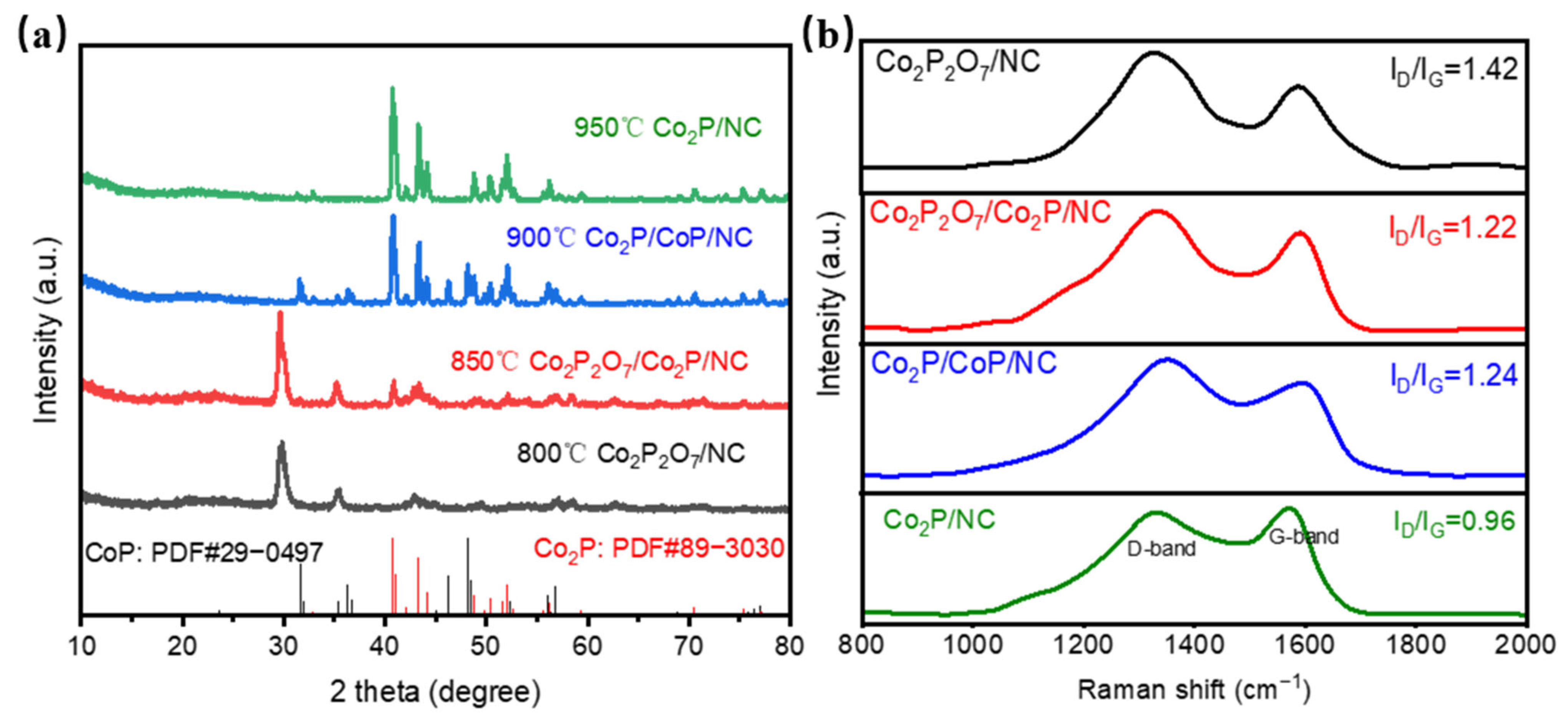

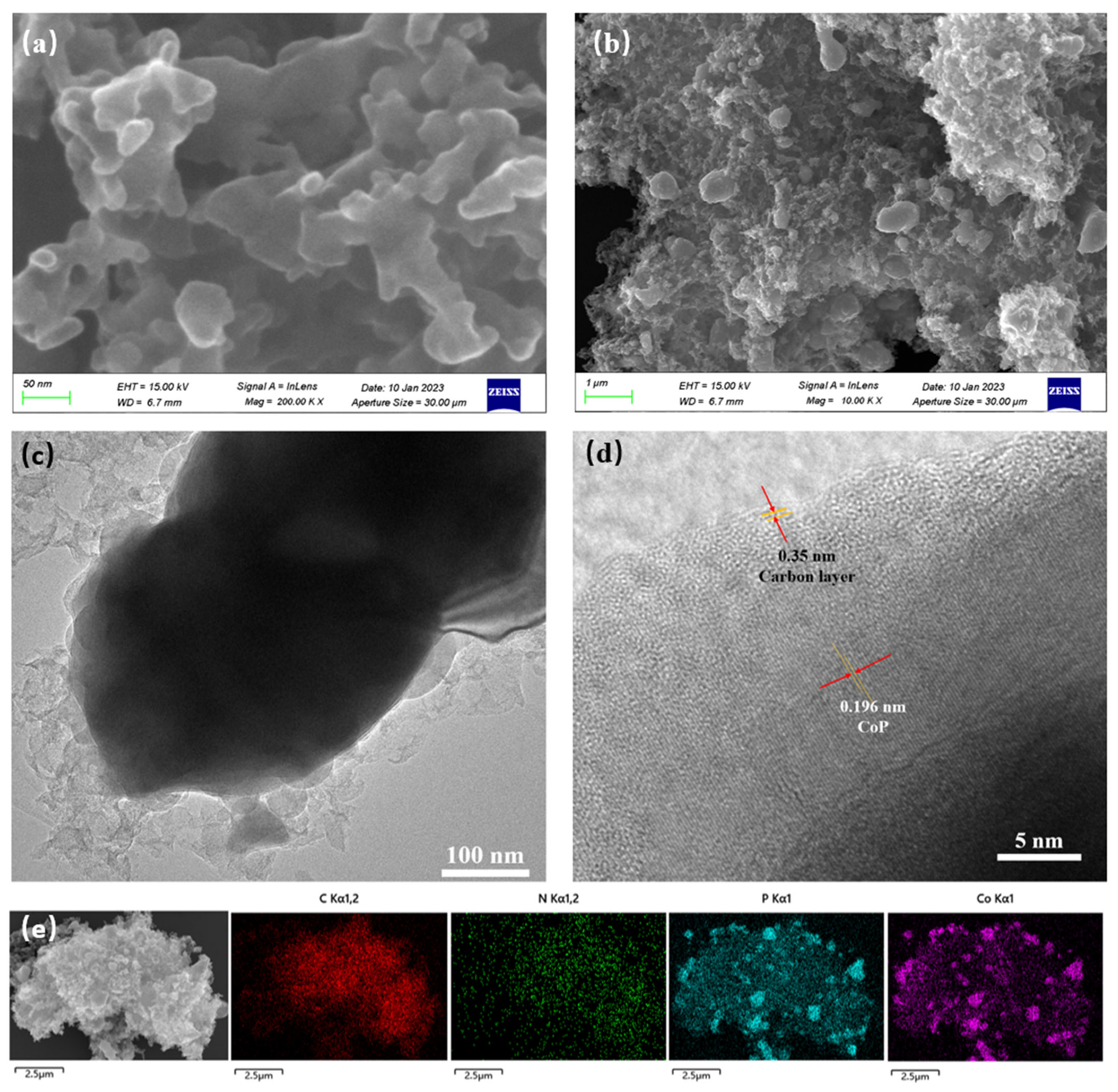
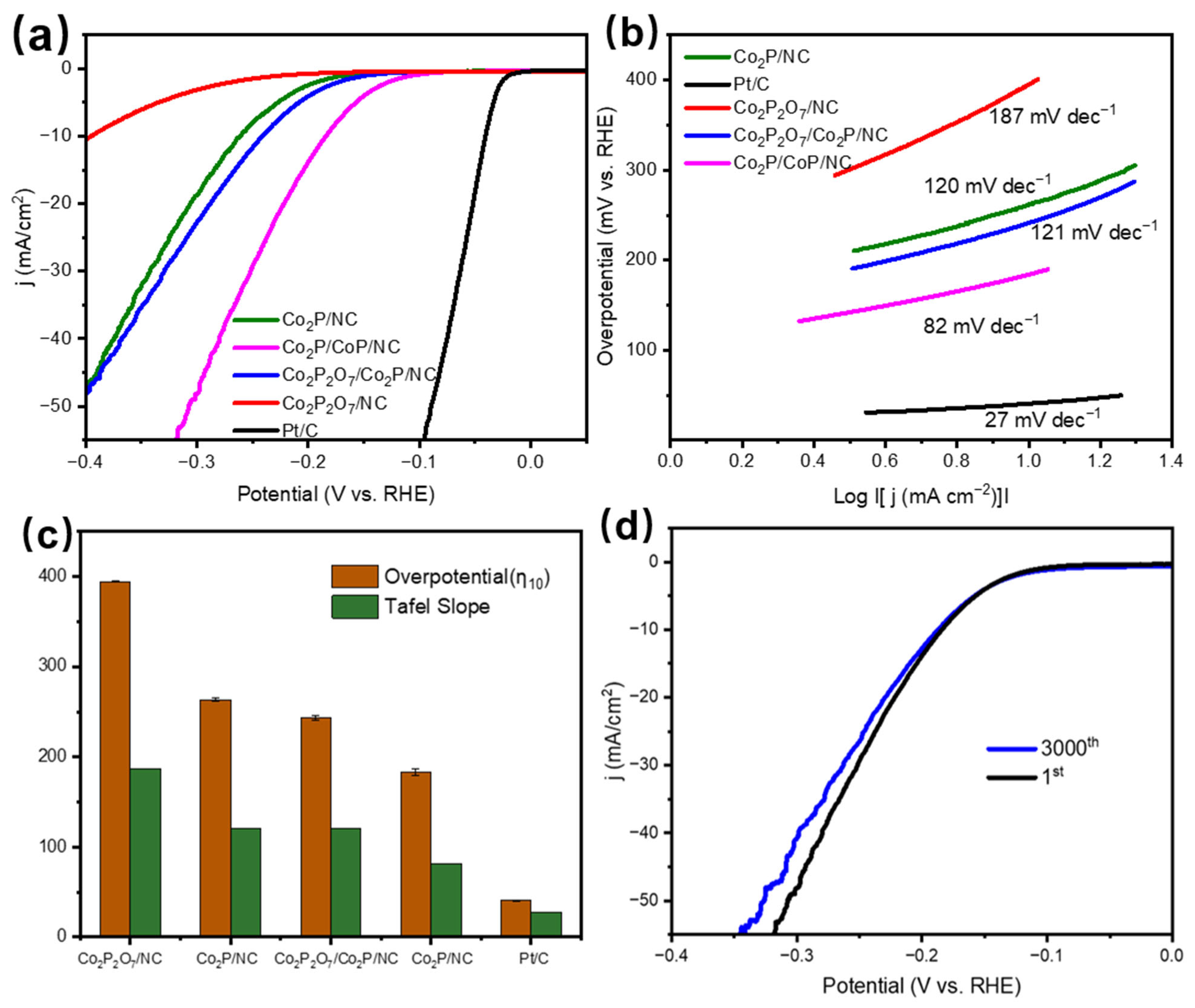
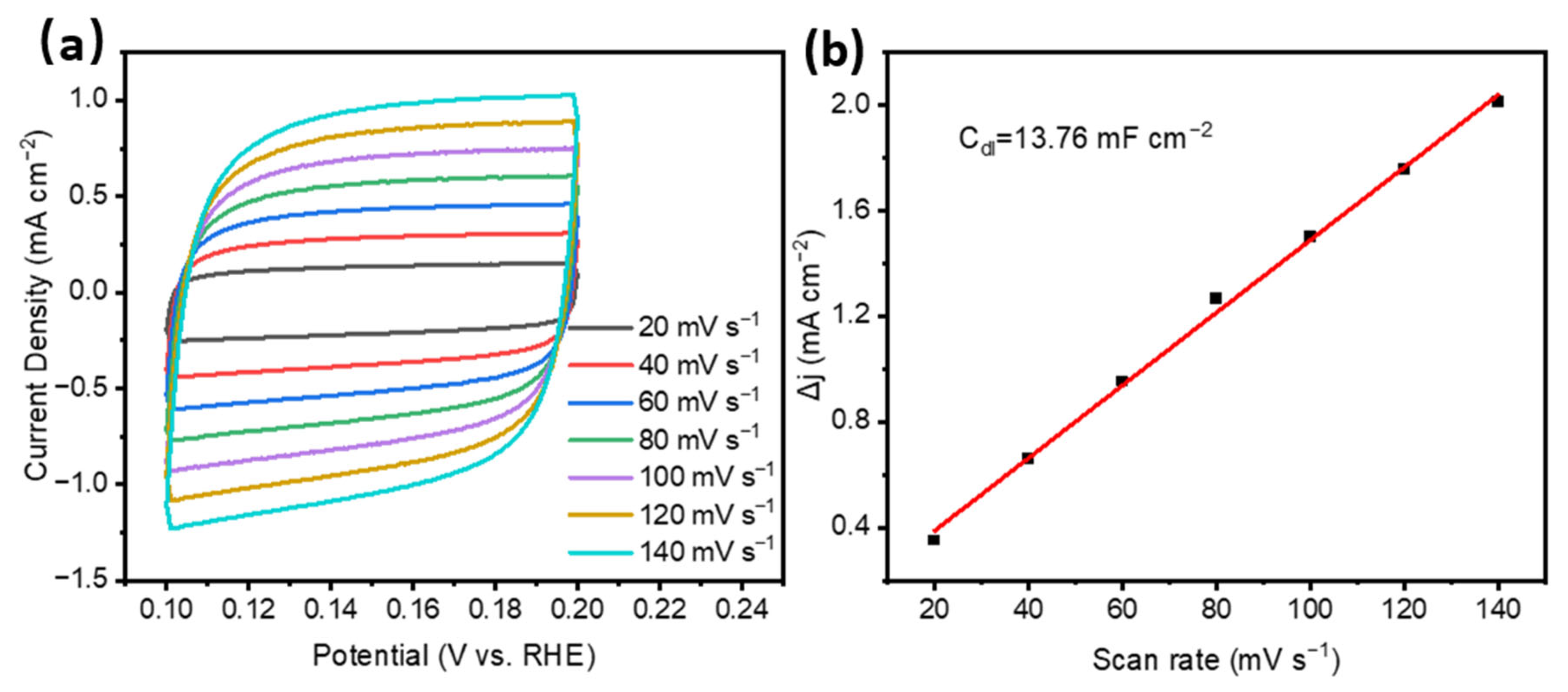
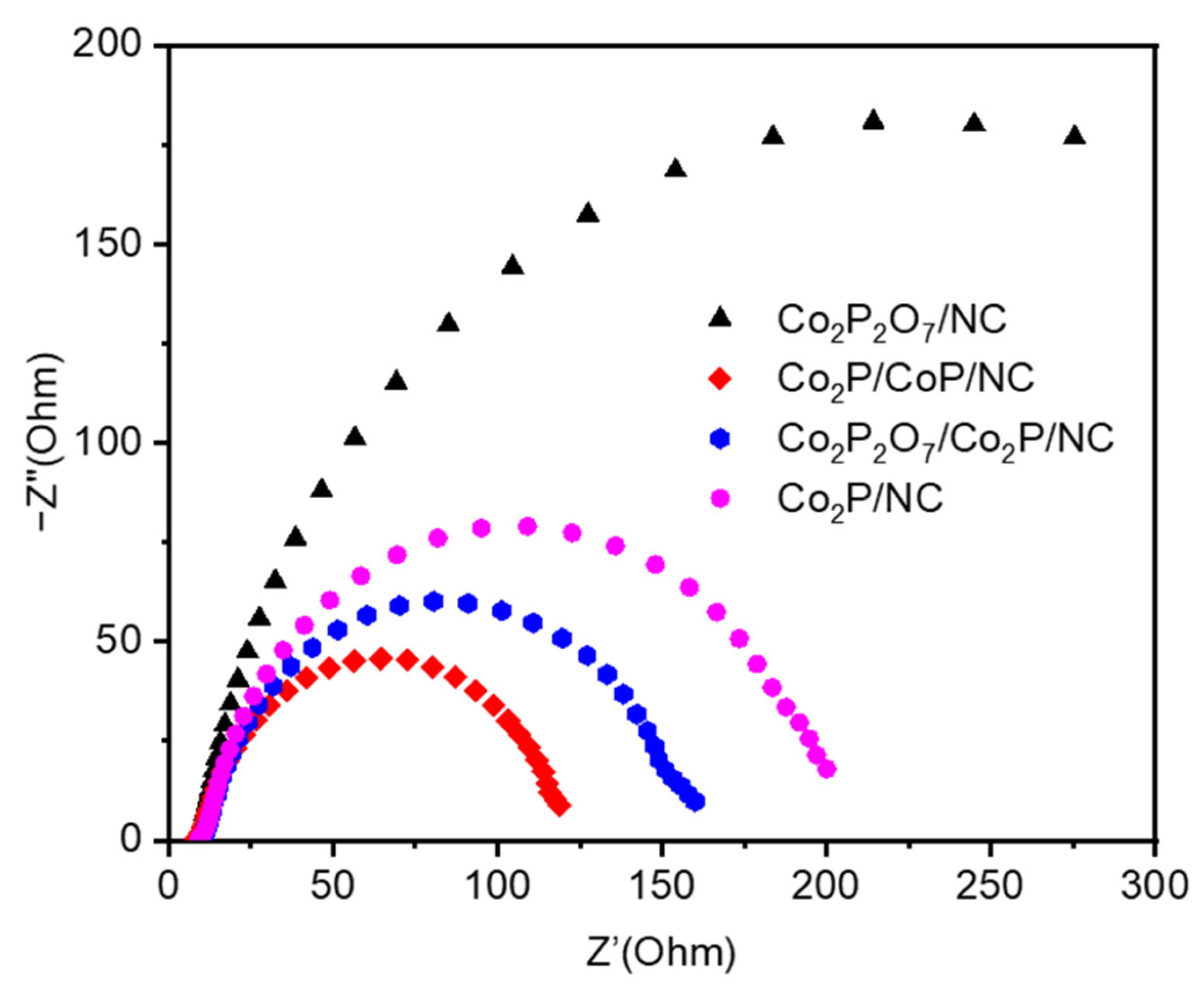
Disclaimer/Publisher’s Note: The statements, opinions and data contained in all publications are solely those of the individual author(s) and contributor(s) and not of MDPI and/or the editor(s). MDPI and/or the editor(s) disclaim responsibility for any injury to people or property resulting from any ideas, methods, instructions or products referred to in the content. |
© 2023 by the authors. Licensee MDPI, Basel, Switzerland. This article is an open access article distributed under the terms and conditions of the Creative Commons Attribution (CC BY) license (https://creativecommons.org/licenses/by/4.0/).
Share and Cite
Lei, Y.; Lin, F.; Hong, N.; Zhang, J.; Wang, Y.; Ben, H.; Li, J.; Ding, L.; Lv, L. In Situ Construction of a Co2P/CoP Heterojunction Embedded on N-Doped Carbon as an Efficient Electrocatalyst for a Hydrogen Evolution Reaction. Materials 2024, 17, 87. https://doi.org/10.3390/ma17010087
Lei Y, Lin F, Hong N, Zhang J, Wang Y, Ben H, Li J, Ding L, Lv L. In Situ Construction of a Co2P/CoP Heterojunction Embedded on N-Doped Carbon as an Efficient Electrocatalyst for a Hydrogen Evolution Reaction. Materials. 2024; 17(1):87. https://doi.org/10.3390/ma17010087
Chicago/Turabian StyleLei, Ying, Feng Lin, Nengyu Hong, Jian Zhang, Yulin Wang, Haijie Ben, Jianguang Li, Liyong Ding, and Liang Lv. 2024. "In Situ Construction of a Co2P/CoP Heterojunction Embedded on N-Doped Carbon as an Efficient Electrocatalyst for a Hydrogen Evolution Reaction" Materials 17, no. 1: 87. https://doi.org/10.3390/ma17010087
APA StyleLei, Y., Lin, F., Hong, N., Zhang, J., Wang, Y., Ben, H., Li, J., Ding, L., & Lv, L. (2024). In Situ Construction of a Co2P/CoP Heterojunction Embedded on N-Doped Carbon as an Efficient Electrocatalyst for a Hydrogen Evolution Reaction. Materials, 17(1), 87. https://doi.org/10.3390/ma17010087





